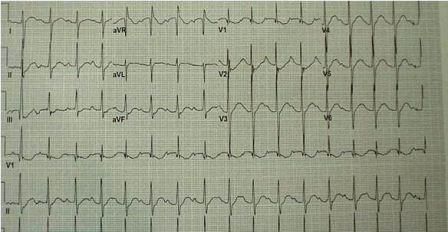Generalized Weakness After Heavy Drinking: Hypokalemia? Ischemia?
The key diagnostic considerations hypokalemia, periodic paralysis, and ischemia should lead the assessment of a patient with acute generalized weakness.
A 38-year-old Asian man with a history of hypertension, depression, and alcohol abuse presented to a walk-in clinic with total body weakness that started when he awoke that morning after drinking heavily the night before. He could barely walk because his legs were so weak; his arms were also extremely weak. He denied any neck or back pain or any numbness or tingling. He also denied headache, trauma, vomiting, tremors, anxiety, or other associated symptoms other than a little “heartburn” similar to what he has had in the past, especially after overeating or otherwise overindulging. He reported that he did not use illicit drugs or smoke tobacco, but said he drank about 12 beers the previous night, which was not unusual.
His medications included hydrochlorothiazide and fluoxetine, but he had not been taking either drug recently.
The patient’s vital signs were normal, except for his blood pressure of 158/94 mm Hg. Other physical findings were normal except for neurologic function. Although cranial nerve function, alertness, and sensation were normal, the patient had 4/5 strength in both arms and legs in symmetric fashion.
The clinic had a laboratory but no imaging services. An ECG was ordered (Figure) and an antacid was given by mouth. The patient’s heartburn resolved after approximately 15 minutes.
To what diagnosis do the ECG findings point?

Figure.
ANSWER: Hypokalemia
The ECG shows many of the classic findings seen in hypokalemia: a U wave, QT prolongation, ST depression in some leads, and a large T wave that fuses with the U wave (sometimes called a “Himalayan T wave”). Some of these findings could also be secondary to ischemia. However the chest symptoms that this patient was having would be considered somewhat atypical for an acute coronary syndrome. The chief complaint of generalized muscle weakness, on the other hand, could certainly be explained by severe hypokalemia.
In a scenario like this with a patient who might have severe hypokalemia or ischemia, transportation to an emergency department (ED) is crucial. This patient was transported to a nearby ED, where his potassium level was noted to be critically low (1.7 mEq/L). Potassium supplementation was initiated and the patient’s weakness drastically improved by the time he was admitted to the hospital. Diagnostic considerations for the cause of the profound hypokalemia included hydrochlorothiazide, although the patient’s admitted nonadherence to his medication regimens made this unlikely. Other possibilities included a new diagnosis of periodic paralysis and/or malnutrition secondary to chronic alcoholism.
Discussion
Hypokalemia may be asymptomatic or it may manifest with muscle weakness, constipation, or polyuria. Most patients do not present with all symptoms. This patient complained only of muscle weakness without bowel or bladder symptoms. With very low potassium levels, usually less than 2.0 mEq/L, severe muscle weakness may occur, as may cardiac dysrhythmias and rhabdomyolysis. The ECG may provide an early warning of impending severely low serum potassium levels.
Suspected hypokalemia should be treated on the basis of ECG results alone in patients who present with severe manifestations; there is no time to wait for results of blood tests. In many EDs, a whole blood potassium level can be determined in a few minutes and, more than likely, will confirm the clinical diagnosis.
Treatment of hypokalemia is usually done via the oral route because of safety and ease of administration. IV access may be used when the patient cannot tolerate oral medication or it may be used to supplement oral treatment when manifestations are severe. Patients should undergo continuous cardiac monitoring during IV potassium therapy.
Admission to the hospital is usually recommended for patients with serum potassium levels of less than 2.5 mEq/L. At these levels, total body potassium stores are usually low, and adequate treatment may require a few days because of limits in rates of potassium administration.
Adequate therapy depends on determining the cause of hypokalemia, which is also the key to preventing its recurrence. Shifts from the vascular to intracellular compartment, diarrhea, and diuretics are among the most common causes. Other causes are listed in the Table, below.
This patient was eventually given a diagnosis of periodic paralysis on the basis of the severe and sudden onset of symptoms and the fact that his potassium levels normalized rapidly in the hospital. The swift stabilization points to intracellular shift as a more likely cause than severe depletion of total potassium stores, which may occur with chronic potassium loss due to medications, diarrhea, or malnutrition.